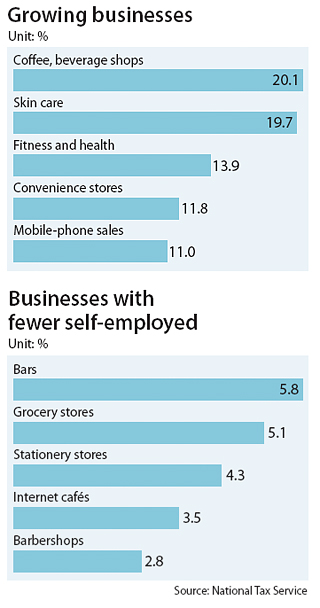Business brewing at coffee shops

The report from the National Tax Services comes at a time when self-employed business risks have been rising due to economic stagnation affected by low growth.
The number of self-employed in 40 business sectors related to basic necessities, such as barbershops, restaurants and skin care, increased 3.4 percent year on year to 1.787 million people, as of August, the NTS said.
Those who run restaurants topped the charts with 508,581 workers, who accounted for 28.4 percent of the number of self-employed, followed by operators of mobile-phone stores (162,281) and real estate agents (105,690). There were 91,658 owners of clothing stores and 91,216 barber shops owners.
Coffee and beverage businesses saw the biggest hike in the number of self-employed entering the market. By the end of August, there were 36,106 self-employed running coffee and beverage shops, a 20.1 percent year on year rise.
More self-employed workers entered health- or cosmetic-related businesses. The number of entrepreneurs in skin care businesses grew 19.7 percent compared to August 2015. Fitness center owners rose 13.9 percent to 5,934. Other businesses such as convenience stores and interior decoration stores were also part of the upward trend.
While more self-employed individuals stepped into sectors such as coffee and cosmetics, the number of self-employed who own bars or grocery stores has shrunk since August 2015.
There were 57,401 bar owners by the end of August, a 5.8 percent decrease in a year. Boosted by the vitalization of online shopping and increase in the number of large discount retailers, those who own small grocery stores have decreased 5.1 percent to 57,788. Businesses like barbershops and stationery stores also followed the downward trend.
Out of 250 major cities and districts, Gangnam, southern Seoul, had the highest concentration of self-employed business owners in those 40 types of businesses, with 32,374. Bucheon, Gyeonggi and Songpa, southeastern Seoul, were close behind with 27,417 and 21,344 self-employed business owners each. The central districts of Busan, Seoul and Daegu had more than 100 self-employed individuals per 1,000 people.
Some self-employed businesses were concentrated more in certain districts than others. For example, among self-employed businesses specializing in photography, 9.2 percent of them were in Gangnam, southern Seoul. Watch and jewelry shop owners were clustered in Jongno, central Seoul and fruit markets in Seogwipo, Jeju Island.
BY HA NAM-HYUN[choi.hyungjo@joongang.co.kr]










with the Korea JoongAng Daily
To write comments, please log in to one of the accounts.
Standards Board Policy (0/250자)